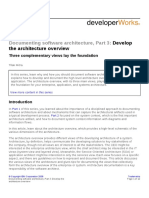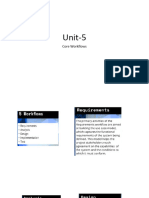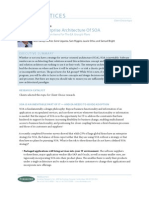Enterprise Architecture
Uploaded by
rpsamy33Enterprise Architecture
Uploaded by
rpsamy33Enterprise Architecture
The definition of an architecture used in ANSI/IEEE Std 1471-2000is: "the fundamental
organization of a system, embodied in its components, their relationships to each other and
the environment, and the principles governing its design and evolution."
An enterprise architecture (EA) is a conceptual tool that assists organizations with the
understanding of their own structure and the way they work. It provides a map of the
enterprise and is a route planner for business and technology change.
Normally an enterprise architecture takes the form of a comprehensive set of cohesive
models that describe the structure and the functions of an enterprise. Important uses of it
are in systematic IT planning and architecting, and in enhanced decision making.
The individual models in an EA are arranged in a logical manner, and this provides an ever-
increasing level of detail about the enterprise, including:
• Its objectives and goals.
• Its processes and organization.
• Its systems and data.
• The technology used.
The business perspective
The business perspective describes how a business works. It includes broad business
strategies along with plans for moving the organization from its current state to an
envisaged future state. It will typically include the following:
• The enterprise's high-level objectives and goals.
• The business processes carried out by the entire enterprise, or a significant portion of
the enterprise.
• The business functions performed.
• Major organizational structures.
• The relationships between these elements.
The application perspective
The application perspective defines the enterprise's application portfolio and is application-
centered. This view will typically include:
• Descriptions of automated services that support the business processes.
• Descriptions of the interaction and interdependencies (interfaces) of the
organization's application systems.
• Plans for developing new applications and revising old applications based on the
enterprises objectives, goals, and evolving technology platforms.
The application perspective may represent cross-organization services, information, and
functionality, linking users of different skills and job functions in order to achieve common
business objectives.
The information perspective
The information perspective describes what the organization needs to know to run its
business processes and operations. It includes:
• Standard data models.
• Data management policies.
• Descriptions of the patterns of information production and consumption in the
organization.
The information perspective also describes how data is bound into the work flow, including
structured data stores such as databases, and unstructured data stores such as documents,
spreadsheets, and presentations that exist throughout the organization.
The technology perspective
The technology perspective lays out the hardware and software supporting the organization.
It includes, but is not limited to:
• Desktop and server hardware.
• Operating systems.
• Network connectivity components.
• Printers.
• Modems.
You might also like
- Fruit Store Management System For Jayani Fresh Fruits - RUP100% (1)Fruit Store Management System For Jayani Fresh Fruits - RUP97 pages
- PPT7-TOPIK7-R0-An Overview of Enterprise ArchitectureNo ratings yetPPT7-TOPIK7-R0-An Overview of Enterprise Architecture33 pages
- Enterprise Architecting: Critical ProblemsNo ratings yetEnterprise Architecting: Critical Problems10 pages
- Building A Formal Enterprise Architecture ModelNo ratings yetBuilding A Formal Enterprise Architecture Model13 pages
- System Integration and Architecture - P1No ratings yetSystem Integration and Architecture - P119 pages
- Architecture Management - Axelos LimitedNo ratings yetArchitecture Management - Axelos Limited29 pages
- Enterprise Architecture Good Practices Guide - Content2 PDF100% (3)Enterprise Architecture Good Practices Guide - Content2 PDF22 pages
- Introduction To Systems Analysis and DesignNo ratings yetIntroduction To Systems Analysis and Design32 pages
- The Components of Enterprise ArchitectureNo ratings yetThe Components of Enterprise Architecture3 pages
- Information System Strategic Planning With Enterprise Architecture PlanningNo ratings yetInformation System Strategic Planning With Enterprise Architecture Planning5 pages
- Unit-1 Introduction To It Infrastructure: Some of The Objectives If IT Infrastructure AreNo ratings yetUnit-1 Introduction To It Infrastructure: Some of The Objectives If IT Infrastructure Are20 pages
- Web-Service Framework For Business Process Modelling & Legacy Systems IntegrationNo ratings yetWeb-Service Framework For Business Process Modelling & Legacy Systems Integration8 pages
- Lecture 2-Enterprise Architecture FrameworksNo ratings yetLecture 2-Enterprise Architecture Frameworks22 pages
- DSI233 Group 2 Solution and EA PresentationNo ratings yetDSI233 Group 2 Solution and EA Presentation25 pages
- Mega Datasheet Mega Enterprise Architecture enNo ratings yetMega Datasheet Mega Enterprise Architecture en12 pages
- Enterprise Application Development Presentation100% (1)Enterprise Application Development Presentation89 pages
- C H A P T E R: Information System Building BlocksNo ratings yetC H A P T E R: Information System Building Blocks21 pages
- Analysis and Design: of E-Commerce SystemsNo ratings yetAnalysis and Design: of E-Commerce Systems27 pages
- Final Enterprise Architecture Modeling New100% (2)Final Enterprise Architecture Modeling New39 pages
- Business Architecture Perspective - Model - techniquesNo ratings yetBusiness Architecture Perspective - Model - techniques5 pages
- SOA-Forrester SOA Enterprise Architecture Best Practices100% (1)SOA-Forrester SOA Enterprise Architecture Best Practices7 pages
- An Overview - Enterprise: Prepare By: Dr. Usman Tariq 08 January 2020No ratings yetAn Overview - Enterprise: Prepare By: Dr. Usman Tariq 08 January 202026 pages
- Application and Technology Rationalization: A Strategic Guide for Midsize to Large Companies: IT and Digital TransformationFrom EverandApplication and Technology Rationalization: A Strategic Guide for Midsize to Large Companies: IT and Digital TransformationNo ratings yet
- Typical Joint Detailing of Steel Hollow SectionsNo ratings yetTypical Joint Detailing of Steel Hollow Sections7 pages
- MHT Cet Chemistry Triumph STD 11th and 12th MCQ Hints156155340050% (2)MHT Cet Chemistry Triumph STD 11th and 12th MCQ Hints1561553400326 pages
- Hybrid Beamforming For DFRC System Based On SINR Performance MetricNo ratings yetHybrid Beamforming For DFRC System Based On SINR Performance Metric6 pages
- UA SRG JEE Adv. 24 Assignment Result PCM (12,13 - March - 2024)No ratings yetUA SRG JEE Adv. 24 Assignment Result PCM (12,13 - March - 2024)3 pages
- L3 - Representing Instructions in The ComputerNo ratings yetL3 - Representing Instructions in The Computer13 pages
- Chapter 6 Functions: For Educational Purpose Only. Not To Be Circulated Without This BannerNo ratings yetChapter 6 Functions: For Educational Purpose Only. Not To Be Circulated Without This Banner132 pages
- Gujarat Technological University: ContentNo ratings yetGujarat Technological University: Content5 pages
- Image Compression: Mohamed N. Ahmed, PH.DNo ratings yetImage Compression: Mohamed N. Ahmed, PH.D67 pages
- Atomization For Spray Drying Unanswered Questions and Industrial NeedsNo ratings yetAtomization For Spray Drying Unanswered Questions and Industrial Needs6 pages
- Design of Long Span Concrete Box Girder Bridges: Challenges and SolutionsNo ratings yetDesign of Long Span Concrete Box Girder Bridges: Challenges and Solutions11 pages
- 111 112 103 104 110 102 U V W EGR Valve MotorNo ratings yet111 112 103 104 110 102 U V W EGR Valve Motor1 page

























































































